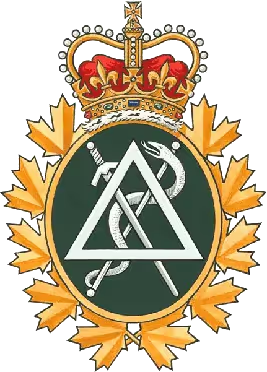Canadian Expeditionary Force (8B) Canadian Army Dental Corps
Canadian Army Dental Corps

(Private Collection)
Prior to its formation as a separate entity under General Orders 63 of 1915 and 103a of August 15th 1915the Canadian Army Dental Corps was an element of the C.A.M.C. designated ‘The Dental Services of the Canadian Army Medical Corps’. Dental surgeons were an integral part of the CAMC units of the 1stContingent when this proceeded to England in October 1914 and on to France in 1915. On March 29th 1915 the Canadian Army Dental Corps was organized to care for all matters affecting the personnel of the Overseas Military Forces of Canada. Overseas the plan on formation was for one officer in charge of all dental surgeons designated as the ‘Chief Dental Surgeon’. (a lieutenant-colonel). Attached to Divisional headquarters a Major and in each Artillery Brigade and divisional ammunition column and the Mounted Rifles Brigade one dental surgeon. (a captain). For each infantry brigade two dental surgeons (lieutenants)these attached to brigade headquarters. Also one dental surgeon was attached to each field ambulance, stationary hospital and general hospital and at the base hospital one in charge of medical stores and equipment. (a captain). An additional dental surgeon was attached to divisional headquarters for units not covered by the above. Each officer was allotted two other ranks one as an orderly (a sergeant or corporal) the other as a ‘batman’. The establishment of each overseas contingent of the Canadian Army Dental Corps on the 26th April 1915 being set at 19 officers and 38 other ranks a total of 57 all ranks.
The Canadian Army Dental Corps (Overseas)
The Dental Services for the Canadian Corps in France were supervised by the Director of Medical Services while those in the United Kingdom and in Canada came under the supervision of the Director of Dental Services, this being established in 1917. At the time of the armistice in November 1918 on the continent were 76 officers, 76 NCOs and 64 other ranks. In England 147 Officers, 145 NCOs and 174 other ranks.

(York Sunbury Historical Society, Fredericton Region Museum collection, Author Photo)
1997.28.503.
RCDC, Queen's crown, post 1952.
The Royal Canadian Dental Corps (RCDC) present day.
The RCD is a branch of the Canadian Armed Forces (CAF). Most members of RCDC, along with the members of the Royal Canadian Medical Service, are employed in the Canadian Forces Health Services Group (CF H Svcs Gp) within the Military Personnel Command reporting to the Chief of Military Personnel. All members of RCDC wear Army uniform. The branch was first raised in 1915 as the Canadian Army Dental Corps and was known from 1947 until 1968 as The Royal Canadian Dental Corps. From 1968 to 2013 the branch was previously named the Dental Branch. 1 Dental Unit is composed of military and civilian personnel providing dental care to the Canadian Armed Forces in both garrison and while deployed overseas.
General Order No 63 was issued on 13 May 1915, authorizing the Canadian Army Dental Corps (CADC) as a separate corps. In anticipation of this general order, on 29 March 1915 authorization was published to appoint "one officer in charge of all dental surgeons, to be attached to divisional headquarters …, to be designated 'Chief Dental Surgeon' as well as an establishment of dental officers for brigades, divisions, base hospitals and field ambulances. This provided a war-time establishment for the new CADC, with a lieutenant-colonel Chief Dental Surgeon for each division. A few days later Colonel John Alexander Armstrong was promoted, named the Director of Dental Services, and assigned to Canadian Corps Headquarters in London.
After the Second World War, a series of coloured berets were adopted, with other arms and services wearing midnight blue berets, with a large coloured "flash" in corps colours – emerald green for the Royal Canadian Dental Corps. The NCMs of the RCDC were composed of four specific trades. Dental technicians, dental hygienists, dental laboratory technicians and dental equipment repair technicians. After numerous cutbacks and restructuring, only dental technicians and dental hygienists remain. Laboratory services (fabrication of crowns, bridges, dentures, etc.) are sent out for fabrication at numerous civilian dental labs across the country. Minor equipment repairs are done in house by dental technicians, all major repairs and routine maintenance and warranty work is completed by civilian companies who compete for the contract to maintain the equipment. While deployed, the dental technicians and biomedical equipment technicians work to keep equipment functioning.
When the Army, Royal Canadian Navy, and Royal Canadian Air Force were merged in 1968 to form the Canadian Forces, the Royal Canadian Dental Corps and Royal Canadian Army Medical Corps were deactivated and merged with their naval and air force counterparts to form the Dental Branch and the Canadian Forces Medical Service of the Canadian Forces Health Services Group (CF H Svcs Gp). The rifle green beret was adopted as the CF standard.
An announcement dated 9 October 2013 revived the title Royal Canadian Dental Corps for the Dental Branch of the Canadian Armed Forces. "The bestowing and restoration of the Canadian Forces Health Services historical names is an essential part of the government's commitment to honour the memories of so many brave Canadians who have sacrificed in service to Canada," said Rob Nicholson, Minister of National Defence. "It reinstates an important and recognizable part of our military heritage, as well as a key part of our nation's identity." (The History and Heritage of the Royal Canadian Dental Corps: A Century of Military Dental Service By Major Richard Groves, CD, and Wikipedia)


